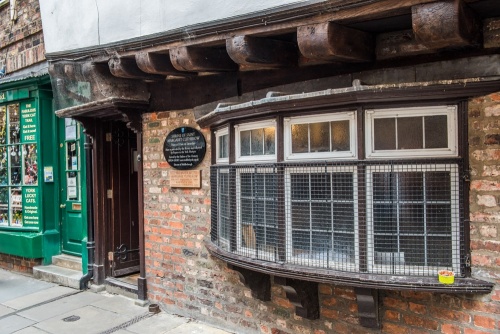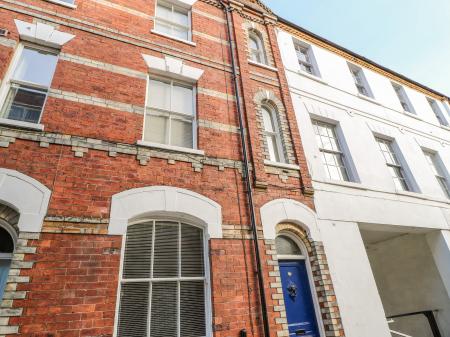
The shrine is not actually in Margaret Clitherow’s house; she is thought to have lived at 11-12 The Shambles, but the shrine is in a similar Tudor house at 35-36 The Shambles, across the road.
Margaret Clitherow was born in 1553, the daughter of a Sheriff of York and churchwarden of St Martins, Colney Street. In other words, she was born to a respectable, well-to-do family. A Protestant family, it should be noted.

At the age of 15, she married a prosperous meat merchant named John Clitherow (alternately spelled Clitheroe) and moved to this modest house in The Shambles, where the butchers of York held sway.
Sometime in the 1570s, Margaret was converted to Catholicism on the instigation of the wife of Dr Thomas Vavasour, a prominent Catholic in York.
This posed a problem for John Clitherow, who held responsibility for reporting suspected Catholics to the authorities. But it seems that for the most part, her husband was happy to look the other way and tolerate his wife's religious activities, and her insistence on educating their children as Catholics.

However in 1577, Margaret was cast into prison, not for worshipping as a Catholic, but for failing to attend Anglican services. Two further prison sentences followed, the longest lasting 20 months. She learned to read Latin while in prison so that she could both read and speak a Catholic service.
In 1581 an Act of Parliament made it an offence to attend a Catholic service for worship or to offer a hiding place to Catholic priests. Harbouring a priest was an offence punishable by death. The method of execution involved being pressed to death under a heavy weight, though such an extreme sentence was rarely carried out.
Margaret Clitherow built a secret chamber within her house in The Shambles, where priests could hide from the authorities. She also made a secret cupboard, where she hid vestments, plus wine and bread for saying Mass. In March 1586 a raid swooped down on the house.
A priest who was sheltering in the house made good his escape, but a frightened boy revealed the location of the secret chamber, and Margaret Clitherow was arrested and tried at York's Guildhall. She refused a trial by jury, saying, "I know of no offence whereof I should confess myself guilty. Having made no offence, I need no trial."

She was aware that if a trial was held, her children would almost certainly be forced to testify against her. This refusal to accept a trial all but guaranteed her a death sentence.
Though the judges tried in vain to persuade her to renounce her Catholic faith and avoid the death sentence, Clitherow refused. She got little sympathy, even from her relations; her stepfather, Henry May, then Lord Mayor of York, said that she had committed suicide.
On 25 March 1586 Margaret Clitherow was transported to the Toll Booth on Ouse Bridge, and there pressed to death under a weight of some 7-8 cwt (hundredweight), about 800-900 pounds. She died within a quarter of an hour. In a somewhat odd twist, Elizabeth I wrote an official letter to the citizens of York, expressing her horror at the execution, and saying that Margaret should have been spared due to her gender.
It is quite possible that one of the people watching Margaret Clitherow's execution that day was a young native of York called Guy Fawkes. At least one prominent historian credits the horror of Clitherow's death as the seminal event that turned Fawkes to Catholicism. Eventually, his religious fervour involved him in the Gunpowder Plot attempt to overthrow the staunchly Protestant James I.

In October 1970 Margaret Clitherow was canonized as one of 40 English martyrs by Pope Paul VI, who called her "the Pearl of York". Her house on The Shambles is now a shrine to this remarkable woman, who is the patron saint of the Catholic Women's League.
Margaret Clitherow's House is open to all, without charge, though a small donation is requested. There is one room on view to the public, presented as a small chapel with a plaque telling Clitherow's life story. There are two statues inside the chapel, one of Margaret Clitherow and the other of the Blessed Thomas Thwing.
The Blessed Thomas Thwing
Thwing was born at Heworth Hall in 1633. He studied for the priesthood in France and was ordained in 1665. He was sent back to England in secret, at a time when it was illegal for Catholic priests to enter the country. He was captured during the upheaval of Titus Oates' Popish Plot and put on trial in York.
He was found guilty and sentenced to death. the sentence was carried out on 23 October 1680 at Knavesmire (the York Tyburn) where he was hanged, drawn, and quartered. In a speech before his death, he denied any treason against the king and forgave his accusers and the jury. He was buried in a vault at St Mary's church, Castlegate where you can see a memorial plaque in his honour.

At the Bar Convent near Micklegate they hold a relic, said to be St Margaret Clitherow's hand. A plaque at the Micklegate end of the Ouse Bridge marks the site of her execution.
Though the main entrance to Margaret Clitherow's House is on The Shambles, you really get a much better view of the historic building if you walk around to the rear facade which faces onto the Shambles Market. Here you can clearly see the original timber-framing, and darkened timbers warped with age.
 We've 'tagged' this attraction information to help you find related historic attractions and learn more about major time periods mentioned.
We've 'tagged' this attraction information to help you find related historic attractions and learn more about major time periods mentioned.




